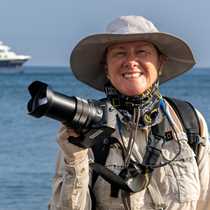Zapote & Supay Rivers
We had travelled overnight back down the Ucayali River almost all night. Soon enough we were leaving in the skiffs for a wildlife watch outing, and this morning I joined the kayaking group. We headed up the river with kayaks in tow to a nice bend in the river where we boarded our crafts in good shade. It was probably around 7:00 a.m. by the time we started paddling (not that I paddled hard, I much prefer drifting) and the sun was already coming over the treetops. Immediately we found ourselves facing a large troop of squirrel monkeys. Because we were somewhat silent, they continued foraging above us, grabbing insects and who-knows-what-else, checking out dead leaves, climbing, jumping, and squeaky-chittering to each other.
The skiffs had continued farther up the river in search of wildlife, but we all convened in front of a community of “ribereños” that looks after this wonderful river. They make sure no illegal logging takes place, just sustainable cutting of necessary timber. They also control hunting and fishing here. As a consequence, this river is in excellent condition, with healthy forest along the banks and plenty to keep us busy with our binoculars.
In order to make a few soles, the women of the community make necklaces and other items from the seeds of the rain forest, sometimes quite intricate bracelets woven with palm fiber that they collect and prepare and thread with different colored seeds from a variety of plants. We stopped for a few minutes to support the local economy and to give the children school supplies—always a useful item anywhere in the world.
The afternoon excursion turned out to be an adventure I never expected. The local naturalists knew of a community far, far up a river that was rarely visited, and so we set our sights on getting there in order to deliver the last of our school supplies and a soccer ball. The Supay River we have often visited for its biodiversity, slow current and lush vegetation. Today we bypassed all that to speed up and attempt to get to this community of “Etnia Maceses.” It wasn’t sure we could reach them because the river levels were just starting to rise for the season.
The most difficult part of our journey was crossing a wide open lagoon because the navigation channel was not clear and the area very shallow. Many times our props caught up vegetation and had to be cleared; we went up dead ends…and finally came across some Maceses in their little dugout, brought on a young boy who perched on the bow and showed us the way to his community.
Of course our arrival caused quite a bit of excitement since these people hadn’t had visitors in months because of the low river levels. The kids were gentle when they greeted us with Bixa orellana paint for our cheeks, and we were shown their new schoolroom (for the 11 kids of school-age). The posts were up, but their government-promised generator for light hadn’t yet arrived. One day soon, they hoped. A couple men were invited to shoot one of their bows and arrows…the real deal.
All too soon we had to return, for the light was getting low and our route long (although now we knew how to cross the lagoon). I couldn’t leave without Jacqueline, one of the women leaders of the community, giving me several big hugs and extracting from me the promise of a return in the future.
And so our last day in the Peruvian Amazon reinforced my belief in “expect the unexpected.” We will never know what lies around the bend in the river unless we go and look.




